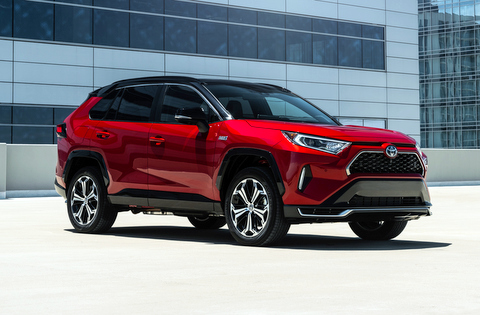37 Miles of Range, 100 MPGe, Under $35,000 Price
Designed to Go Head-to-Head with Toyota RAV4 Prime
The plug-in SUV battle is heating up with Ford releasing details of the official fuel economy numbers for its 2020 Ford Escape Plug-in Hybrid that should be on sale soon. Up to now you had three choices—the Mitsubishi Outlander PHEV, the newer and smaller Kia Niro Plug-in Hybrid or the also new Hyundai Kona Electric. The latter two are really wagons passing themselves off as proto-SUVs, but we’ll let that pass.

Over the next few months to major players promise to turn this market segment into a serious competition as two powerhouses charge into the market—the 2020 Ford Escape Plug-in Hybrid and the 2021 Toyota RAV4 Prime. While similar, we now have comparative specs for the two for shoppers eager to put shelter-in-place behind and take off for the summer with cargo space for the family and gear. Here’s a run-down of the two.
On-Sale Date
Escape PHEV – soon
RAV4 Prime – summer
EV-only Range
Escape – 37 miles
RAV4 – 39-42 miles

EPA Rating
Escape – 100 MPGe*
RAV4 – 94 MPGe*
*MPGe is the federal EPA’s measurement accounting for the energy-equivalent fuel economy of electricity.
Total System Horsepower
Escape 200 horsepower (FWD only)
RAV4 302 horsepower (AWD only)
Starting Price
Escape – $34,285 (before incentives)
RAV4 – $38,100 (before incentives)
Models
Escape – SE, SEL, Titanium
RAV4 – XE, XSE
Storage Behind the Rear Seat
Escape – 34.4 cubic feet
RAV4 – N/A
While Toyota is pitching the RAV4 Prime as the “fastest four-door vehicle” in its lineup, Ford is pushing the Escape PHEV’s fuel efficiency and functionality. Both have a long line-up of standard and optional safety equipment and advanced driver assistance systems (ADAS). When I had a chance to drive the non-plug-in hybrid Escape last year (and get a sneak peek at some of the PHEV technology), I was impressed the advances in this generation’s efficiency and packaging.

The 2020 Ford Escape benefits from the redesign of the model last year that resulted in better integration of the battery pack than was found on previous plug-in models like the Fusion and C-Max Energi. With its 14.4-kilowatt hour battery tucked under the second-row seats, no cargo space is lost, retaining one of the key traits of a crossover.
The Escape and RAV4 PHEVs look like they will bracket their main competition in price, the Mitsubishi Outlander, which starts at $37,490 in AWD. All three have substantially more space than the Kia Niro PHEV (compared its 19.4 cubic feet of storage behind the second-row seat to the Escape’s 34.4. Of course, the Niro does have a significant price advantage, starting at $29,490.
Choice Is Good
The bottom line is with choice comes decisions. If you’re looking for a plug-in hybrid crossover (setting aside for the moment there are some luxury models that are a separate category), you can slice the market several ways:

- Is price you major concern? If so, the Escape looks like the bargain in this market unless you downsize to the Niro.
- Is AWD a must? Then the Outlander is your car, unless you want to wait to check out the RAV4.
- Is maximum all-electric range critical? Looks like the RAV4 takes the cake, albeit by so few miles you may or may not notice.
- How about maximum functionality, i.e., storage space? Back to the Escape again, although we haven’t heard the final word from Toyota and its RAV4 Hybrid specs edge out the Escape Hybrid.
Choice is good. It complicates things, but it means you have the chance to focus on what you really want. The growing plug-in crossover segment looks like it’s finally setting up to make your life better, if more complicated.
Related Stories You Might Enjoy—The PHEV Crossover Competitors
Road Test: 2019 Mitsubishi Outlander PHEV
Road Test: 2019 Toyota RAV4 Hybrid
Flash Drive: 2020 Ford Escape Hybrid
News: Ford Adds Plug-in Hybrid Escape
Road Test: 2018 Kia Niro PHEV

11 thoughts on “News: Ford Releases Details on Plug-in Hybrid Escape”